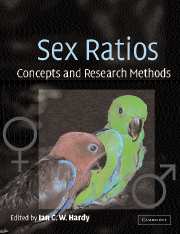Book contents
- Frontmatter
- Contents
- List of contributors
- Preface and acknowledgements
- Part 1 Sex ratio theory
- Part 2 Statistical analysis of sex ratio data
- Part 3 Genetics of sex ratio and sex determination
- Part 4 Animal sex ratios under different life-histories
- Part 5 Sex ratios in plants and protozoa
- Part 6 Applications of sex ratios
- Chapter 18 Operational sex ratios and mating competition
- Chapter 19 Using sex ratios: the past and the future
- Chapter 20 Using sex ratios: why bother?
- Index
- References
Chapter 19 - Using sex ratios: the past and the future
Published online by Cambridge University Press: 06 August 2009
- Frontmatter
- Contents
- List of contributors
- Preface and acknowledgements
- Part 1 Sex ratio theory
- Part 2 Statistical analysis of sex ratio data
- Part 3 Genetics of sex ratio and sex determination
- Part 4 Animal sex ratios under different life-histories
- Part 5 Sex ratios in plants and protozoa
- Part 6 Applications of sex ratios
- Chapter 18 Operational sex ratios and mating competition
- Chapter 19 Using sex ratios: the past and the future
- Chapter 20 Using sex ratios: why bother?
- Index
- References
Summary
Summary
Our understanding of the evolution of sex ratios has advanced substantially in recent decades, in part due to the important work of Hamilton (1967) on ‘extraordinary sex ratios’. However, important aspects of the biology have largely remained unstudied, including the mating dynamics and structure of natural populations, the role of the individual in producing observed sex ratios, and the nature of sex ratio control. Also little studied is how tests of sex ratio models should be structured so as to provide maximum insight. Perhaps ignoring these facets of the biology has aided progress in the past, but these gaps in the study of sex ratios are now blindspots, which hinder understanding. Further progress in the evolutionary analysis of sex ratios requires their elimination. This can be accomplished only by direct investigations of mating dynamics, population structure and the behaviour of individuals.
Introduction
Every great scientific theory is a partial lie about nature. This is not a claim about scientific fraud, as the issue is not one of honesty in the usual sense. Instead, it is a claim about how theories succeed (Cartwright 1984). A theory can succeed by explaining facts correctly. It can also succeed by making facts appear irrelevant or unimportant, sometimes correctly but sometimes incorrectly. Such facts sometimes resurface, but sometimes they are never seen again (Lewontin 1991). To this extent, the lie arises because nature is not described, as much as it is created from some facts while others are eliminated and left unexplained.
- Type
- Chapter
- Information
- Sex RatiosConcepts and Research Methods, pp. 383 - 398Publisher: Cambridge University PressPrint publication year: 2002
References
- 13
- Cited by



